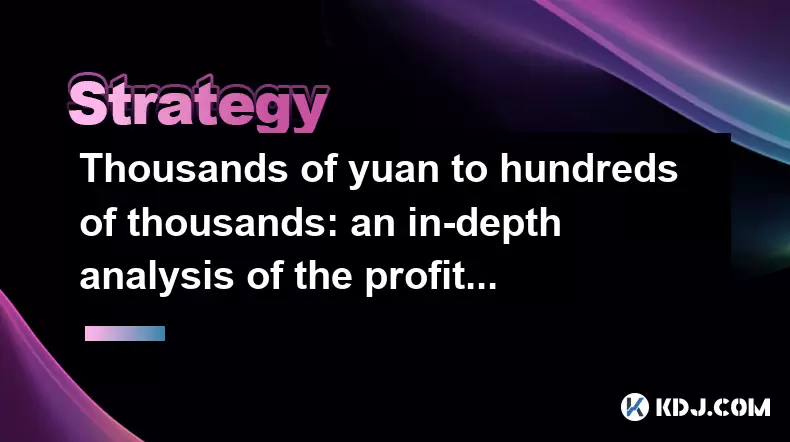-
 bitcoin
bitcoin $109547.008142 USD
0.04% -
 ethereum
ethereum $4011.838726 USD
-0.05% -
 tether
tether $1.000402 USD
-0.01% -
 xrp
xrp $2.798606 USD
0.88% -
 bnb
bnb $970.877944 USD
1.39% -
 solana
solana $202.237275 USD
-0.95% -
 usd-coin
usd-coin $0.999673 USD
0.00% -
 dogecoin
dogecoin $0.229294 USD
-1.15% -
 tron
tron $0.336370 USD
-0.45% -
 cardano
cardano $0.777260 USD
-1.66% -
 hyperliquid
hyperliquid $45.503019 USD
1.73% -
 ethena-usde
ethena-usde $1.000362 USD
0.01% -
 chainlink
chainlink $20.785303 USD
-1.10% -
 avalanche
avalanche $28.755822 USD
-0.11% -
 stellar
stellar $0.358303 USD
-0.48%
Thousands of yuan to hundreds of thousands: an in-depth analysis of the profiteering gameplay of digital currency
Digital currency traders can profit from thousands to hundreds of thousands of yuan by understanding market trends, using advanced techniques, and managing risks effectively.
Jun 08, 2025 at 04:01 am

In the world of digital currency, the potential for profits can range from thousands to hundreds of thousands of yuan. This article delves into the various strategies and methods employed by traders and investors to achieve such lucrative outcomes. From understanding market trends to leveraging advanced trading techniques, we will explore the profiteering gameplay of digital currency in depth.
Understanding Market Trends and Timing
The key to making substantial profits in the digital currency market lies in understanding market trends and timing. Successful traders often spend a significant amount of time analyzing market data, historical price movements, and current events that could influence cryptocurrency prices. By identifying patterns and predicting future movements, they can buy low and sell high, maximizing their returns.
To effectively understand market trends, traders use a variety of tools and resources. Technical analysis involves studying charts and using indicators like moving averages, Relative Strength Index (RSI), and Bollinger Bands to predict price movements. Fundamental analysis, on the other hand, focuses on the intrinsic value of a cryptocurrency, considering factors such as the project's team, technology, and adoption rate.
Timing is equally crucial. Entering the market at the right moment can significantly impact profitability. Traders often use trading signals and market sentiment analysis to determine the best times to buy or sell. Platforms like TradingView and Coinigy offer real-time data and insights that can help traders make informed decisions.
Leveraging Advanced Trading Techniques
Beyond basic market analysis, leveraging advanced trading techniques can further enhance profitability. One such technique is margin trading, which allows traders to borrow funds to increase their trading position. While this can amplify profits, it also increases the risk of significant losses, so it should be approached with caution.
Another advanced technique is arbitrage trading, where traders exploit price differences between different exchanges. For example, if Bitcoin is trading at a lower price on one exchange compared to another, a trader can buy it on the first exchange and sell it on the second, profiting from the price discrepancy. This requires quick execution and access to multiple trading platforms.
Algorithmic trading is also gaining popularity among digital currency traders. By using algorithms and automated trading bots, traders can execute trades based on predefined criteria without constant manual intervention. This can help take advantage of market opportunities 24/7, potentially increasing profits.
Diversification and Portfolio Management
Diversification is a fundamental principle in investment, and it applies to digital currency trading as well. Diversifying your portfolio across different cryptocurrencies can help mitigate risk and increase the chances of achieving significant profits. Instead of putting all your funds into one cryptocurrency, consider spreading your investment across several promising projects.
Effective portfolio management involves regularly reviewing and rebalancing your investments. This means selling assets that have reached their target price and reallocating funds to new opportunities. By staying agile and adapting to market changes, traders can maximize their returns.
When diversifying, it's important to consider different types of cryptocurrencies. For example, investing in both established cryptocurrencies like Bitcoin and Ethereum, as well as newer altcoins with high growth potential, can provide a balanced approach to risk and reward.
Risk Management Strategies
While the potential for high profits in digital currency trading is alluring, it's essential to implement risk management strategies to protect your investments. Setting stop-loss orders can help limit losses by automatically selling an asset when it reaches a predetermined price. This prevents a small loss from turning into a significant one.
Another risk management technique is position sizing, which involves determining the appropriate amount to invest in a single trade based on your overall portfolio and risk tolerance. By not risking too much on any one trade, you can protect your capital and stay in the game longer.
Diversifying your trading strategies can also be a form of risk management. Instead of relying on a single approach, consider combining different techniques like day trading, swing trading, and long-term investing. This can help spread risk and increase the likelihood of achieving consistent profits.
The Role of Psychological Factors
Trading digital currencies is not just about numbers and strategies; psychological factors play a significant role in determining success. Emotions like fear and greed can lead to impulsive decisions that result in losses. Successful traders often develop a trading psychology that helps them stay disciplined and stick to their strategies.
One common psychological trap is FOMO (Fear Of Missing Out), where traders enter the market late due to fear of missing out on potential gains. This can lead to buying at the peak and suffering significant losses when the market corrects. To combat FOMO, traders should stick to their analysis and avoid making decisions based on emotions.
Another psychological factor to consider is risk tolerance. Each trader has a different level of comfort with risk, and understanding your own risk tolerance can help you make more informed decisions. For example, if you're more risk-averse, you might focus on stable, established cryptocurrencies rather than volatile altcoins.
FAQs
Q: Can anyone achieve profits from thousands to hundreds of thousands of yuan in digital currency trading?A: While it's possible, achieving such high profits requires a deep understanding of the market, effective trading strategies, and disciplined risk management. It's not guaranteed and involves significant risk.
Q: How long does it typically take to see significant profits in digital currency trading?A: The time frame can vary widely depending on market conditions and trading strategies. Some traders may see significant profits within weeks or months, while others may take years to build their portfolios to such levels.
Q: Is it necessary to use advanced trading techniques to achieve high profits?A: Not necessarily. While advanced techniques can enhance profitability, many traders achieve significant profits using basic strategies like trend following and fundamental analysis. The key is to find a method that works for you and stick to it.
Q: What are some common pitfalls to avoid in digital currency trading?A: Common pitfalls include trading without a plan, letting emotions drive decisions, and failing to implement proper risk management. It's also important to avoid chasing after every new cryptocurrency without conducting thorough research.
Disclaimer:info@kdj.com
The information provided is not trading advice. kdj.com does not assume any responsibility for any investments made based on the information provided in this article. Cryptocurrencies are highly volatile and it is highly recommended that you invest with caution after thorough research!
If you believe that the content used on this website infringes your copyright, please contact us immediately (info@kdj.com) and we will delete it promptly.
- XRP, Bitcoin Price Predictions: Decoding the Crypto Crossroads
- 2025-09-28 08:25:12
- ChatGPT, Crypto, and Crystal Balls: Predictions for a Wild 2025
- 2025-09-28 08:45:12
- Crypto Clash: Can Kaspa and Pi Coin Compete in a Remittix World?
- 2025-09-28 08:45:12
- Riding the Floki Wave: Gauging Gains with Social Engagement and Bottom Signals
- 2025-09-28 08:25:12
- Bitcoin's $109,000 Support: Will It Hold or Fold?
- 2025-09-28 09:05:14
- Crypto 2025: MoonBull Charges Ahead, Leaving Pepe and Mog in the Dust
- 2025-09-28 08:50:12
Related knowledge

Practical parameter settings for a Bitcoin multi-timeframe moving average system
Sep 18,2025 at 10:54pm
Optimizing Timeframe Combinations for Bitcoin Trading1. Selecting appropriate timeframes is crucial when building a multi-timeframe moving average sys...

How can I filter out false breakouts in Dogecoin high-frequency trading?
Sep 22,2025 at 01:00am
Understanding False Breakouts in Dogecoin Trading1. A false breakout occurs when Dogecoin's price appears to move beyond a defined support or resistan...

Techniques for identifying tops and bottoms in the Bitcoin on-chain NVT model
Sep 20,2025 at 07:54pm
Understanding the NVT Model in Bitcoin Analysis1. The Network Value to Transactions (NVT) ratio is often described as the 'P/E ratio' of the cryptocur...

What does the surge in open interest in Bitcoincoin futures mean?
Sep 20,2025 at 11:18pm
Understanding the Surge in Dogecoin Futures Open Interest1. A surge in open interest within Dogecoin futures indicates a growing number of active cont...

How can I use the Ethereum USDT premium to gauge market sentiment?
Sep 18,2025 at 11:55pm
Understanding the Ethereum USDT Premium1. The Ethereum USDT premium refers to the price difference between USDT (Tether) traded on Ethereum-based plat...

What should I do if Ethereum staking yields decline?
Sep 20,2025 at 06:18am
Understanding the Causes Behind Declining Ethereum Staking Yields1. The Ethereum network transitioned to a proof-of-stake consensus mechanism with the...

Practical parameter settings for a Bitcoin multi-timeframe moving average system
Sep 18,2025 at 10:54pm
Optimizing Timeframe Combinations for Bitcoin Trading1. Selecting appropriate timeframes is crucial when building a multi-timeframe moving average sys...

How can I filter out false breakouts in Dogecoin high-frequency trading?
Sep 22,2025 at 01:00am
Understanding False Breakouts in Dogecoin Trading1. A false breakout occurs when Dogecoin's price appears to move beyond a defined support or resistan...

Techniques for identifying tops and bottoms in the Bitcoin on-chain NVT model
Sep 20,2025 at 07:54pm
Understanding the NVT Model in Bitcoin Analysis1. The Network Value to Transactions (NVT) ratio is often described as the 'P/E ratio' of the cryptocur...

What does the surge in open interest in Bitcoincoin futures mean?
Sep 20,2025 at 11:18pm
Understanding the Surge in Dogecoin Futures Open Interest1. A surge in open interest within Dogecoin futures indicates a growing number of active cont...

How can I use the Ethereum USDT premium to gauge market sentiment?
Sep 18,2025 at 11:55pm
Understanding the Ethereum USDT Premium1. The Ethereum USDT premium refers to the price difference between USDT (Tether) traded on Ethereum-based plat...

What should I do if Ethereum staking yields decline?
Sep 20,2025 at 06:18am
Understanding the Causes Behind Declining Ethereum Staking Yields1. The Ethereum network transitioned to a proof-of-stake consensus mechanism with the...
See all articles










































































